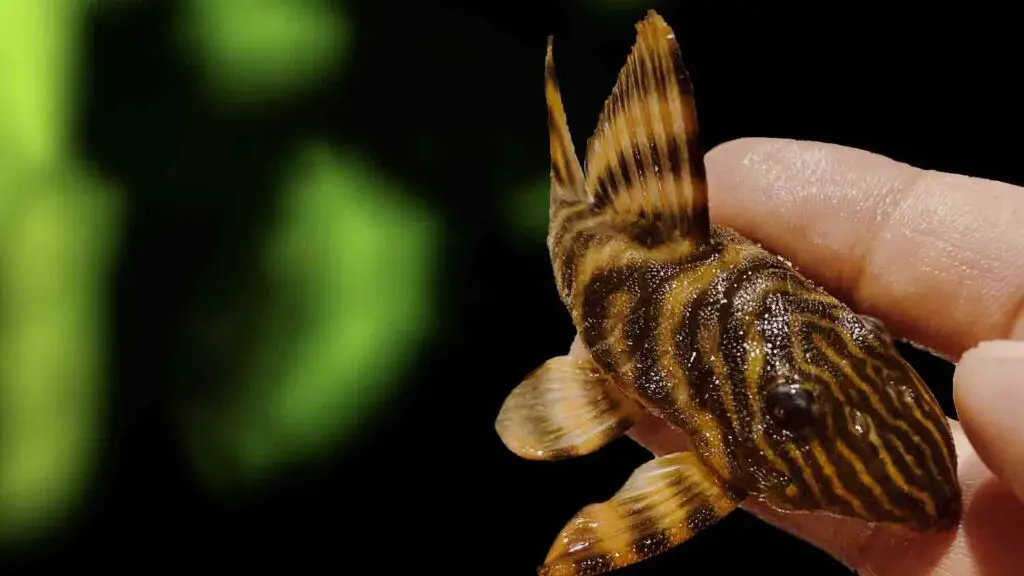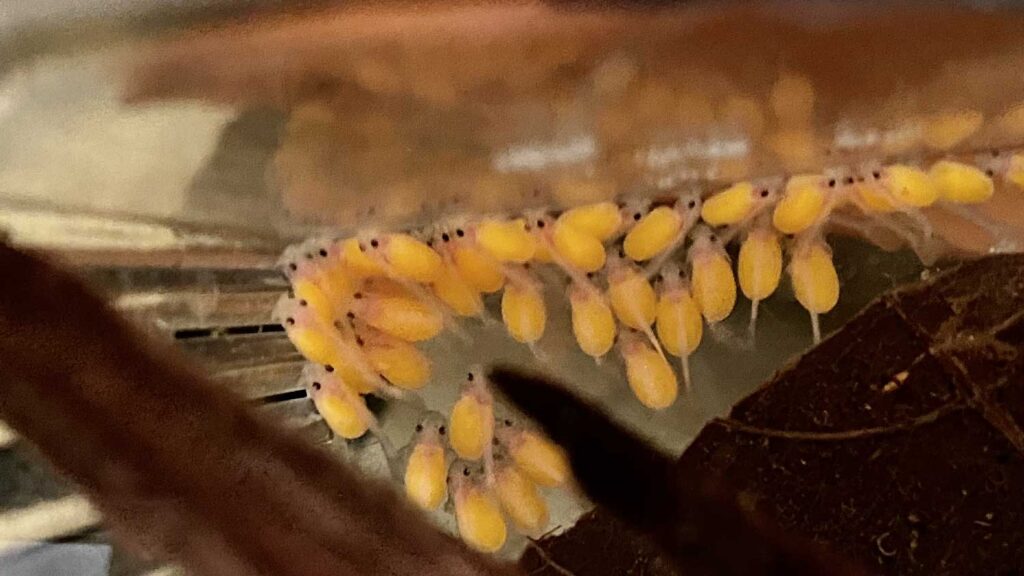The L169 Pleco are beautiful bottom-dwelling freshwater fish that add beauty and functionality to your tank. This fish will constantly search in the tank for any excess food which will keep your tank healthy. They’re very easy to care for and stay small compared to other plecos. Gold Stripe Panaque are also very calm and sociable fish that can live in any community tank.
This guide will help you learn all the information you need to know about L169 Pleco care. By the end of this article, you’ll be ready to bring one of these fish home and be a good parent for it!
Species Profile & Overview
L169 Pleco ( Gold Stripe Panaque ) is a member of the Loricariidae family (plecos) that comes from the Rio Negro in Brazil. These fish have been in the aquarium hobby for many years. This made it possible for local aquarists to breed them locally and in some cases create unique patterns.
They have a bold body that has darke black and orange stripes running along their body. These stripes are perfectly adapted to camouflage fish in the driftwoods which will protect them from predators.
These fish are coming from oxygen-rich warm waterways with a slightly fast water current where visibility is very low. Gold Stripe Panaque are well adapted to this environment and will thrive when the same conditions are created in a tank. In the wild, they mainly feed on wood, algae, freshwater sponges, small crustaceans, and any available plant matter.
These vibrant fish can easily live in your tank when you make a few adjustments. Unlike some kinds of plecos, the Gold Stripe Panaque will only grow to a fairly manageable size which makes them an ideal catfish for most aquariums.
Appearance:

The appearance of the L169 Pleco is the main reason most people get these fish. They have bold patterns and colors that make them stand out in the crowd.
The figure below shows the general mold of the plecos. They have a thick head and body which slowly get thinner towards the tail fin. They have 2 eyes at the top of the head where they can monitor the water column for predators.

Of the 8 fins, plecos have, the dorsal fin and tail fin are the most pronounced. Pectoral fins are the secon large pair of fins that have spines on them. All fins have unique patterns with the same colors as the rest of the body.
L169 Pleco has beautiful orange or gold base color that has dark black stripes running all over its body. The patterns cover the entire back and the head but the belly is usually without dark stripes. Their fins also have these patterns but they are translucent.
Adult Size
The average L169 Pleco size is around 3.1 inches in length when they are fully grown. Males might grow slightly bigger compared to females.
Providing clean water and a diverse diet will encourage this fish to grow faster and maybe bigger. This is extremely important when they are young and at their development ages.
Lifespan
In pristine conditions, Gold Stripe Panaque Pleco lifespan is about 8 – 10 years. This means they need a long-term commitment.
This species is susceptible to illness and other fatal conditions that might occur in a tank environment. This means the actual life expectancy for an individual fish in a specific tank environment might be less.
Behavior and Temperament
The L169 Plecos are fascinating aquarium creatures that are mostly calm and will not cause any trouble in the aquarium. They will continue swimming and scavenging for food without bothering other fish. During the day you might see these guys very little as they are mainly active at night.
When they feel safe, they will go out of their cave even during the daytime. If you have low light levels and no large aggressive fish are available in the tank, they will come out during the day as well.
Males need caves in the aquarium, so you will need to add a pleco cave for each male that you have in the tank. When enough caves are available, the males will each pick a cave and will not fight with each other.
These fish are also known to be very territorial with similar looking bottom-dweller fish. The males are very territorial and will defend their cave to death!

L169 Pleco Care
The good news is that L169 Pleco care is very easy. All you need to do is to make a few basic adjustments in the tank and they will thrive.
That said, you will have to provide them with the right tank parameters if you want them to thrive. They will also need a special diet that is as close to what they get in the wild as possible. This will help your fish live a long and happy life!
You will need to follow the basic guidelines we’ve listed below for the best living conditions and care for your L169 Pleco.
Tank Size
The minimum tank size for a single L169 Pleco is 20 gallons. However, these fish will need bigger space if you have a community tank that is heavily stocked with other fish.
That said, more than one Gold Stripe Panaque plecos will need a much larger tank. These bottom-dwellers need more floor space so the tank’s gallons are not always the best way to see how many plecos you can house.
For Gold Stripe Panaque plecos a wide tank is preferable over a tall tank. This is because high tanks have a smaller floor area than low aquariums of equal volume. Both tanks hold the same amount of water, but the high tank can house fewer plecos due to its narrower floor area. After choosing a suitable tank for your setup, you can add slates, rocks, tiles, and other decorations to give your L169 Pleco even more floor surfaces.
Tank Setup:
The Gold Stripe Panaque plecos are very shy fish and will need lots of hiding spots in the tank. You can place artificial ornaments or natural decorations to create a natural habitat for them. Your tank setup has a direct impact on the stress levels and health of this fish.
Artificial or natural decorations are a great way to create lots of hiding spots for your pleco to feel safe. However, we highly recommend using natural decorations as they provide many benefits to the tank. Placing a large number of rocks and driftwood will make your pleco feel safe. Having natural wood and rocks will also help you maintain balanced aquarium parameters. You should also place a few pleco caves in your tank so your pet pleco can hide during the daytime.
Wood is a vital part of the L169 plecos diet so you will need to place multiple different types of wood in the aquarium so these fish can feed on.
The Gold Stripe Panaque spends the majority of its time at the bottom of the tank. Sharp substrates might injure their soft belly, so softer substrates are highly recommended for this fish. Bigger but round substrates like smaller size pea gravers are also a good option to use. Another type of substrate that you can use is planted tank substrate. Planted substrates are a great option if you are planning to keep plecos and plants in your tank.
Additionally, we highly recommend adding live plants to your aquarium. Live plants are necessary for a healthy setup and can help in cleaning the tank of harmful substances. Your fish will also have several natural hiding spots among the plants’ leaves. You can use floating plants or any other live aquarium plant to enhance the appearance and water quality of your tank.
Water Parameters:
The L169 Pleco comes from relatively fast-moving rivers of South America. The water is always warm and well oxygenated, and TDS is very low at all times. This means you will also need to create a similar environment in your aquarium. Depending on the size of your tank and the number of fish you are keeping, you might need to do more water changes to keep these fish healthy. When enough food is available, these guys will produce significant waste which means you will need to do more maintenance. Below are the tank parameters you can keep Gold Stripe Panaque plecos in:
- Temperature: 75 – 82 Degrees Fahrenheit
- PH: 6 – 7.5
- TDS: 60 – 220 PPM
When you first bring your Gold Stripe Panaque home you will need to perform regular water tests to make sure water parameters are in favor of your pleco. After some time, if you see no fluctuation in the tank, then you will not need to perform as many tests as in the first week. We highly recommend having a TDS (Total Dissolved Solids) meter and changing the water every time the tank’s TDS crosses the recommended range.

Lighting:
L169 Pleco does better in shades which means you should not use strong lights if you don’t have live plants. However, if you keep live plants, you can simply add more caves and hiding spots for them to hide during the time aquarium lights are on.
Filter System:
Like most plecos, L169 Pleco produces a large amount of waste. As a result, a powerful filter will be necessary to ensure that the water in your tank is always clean. Because Gold Stripe Panaque plecos are very susceptible to ammonia surges, you must utilize the most powerful filtering equipment available. Large filters can remove waste while preventing ammonia levels from rising.
Common Diseases and Prevention
Like all other aquarium fish, when tank parameters are not in favor of L169 Pleco, they tend to easily get sick. They are also vulnerable to all common aquarium diseases that any new fish might carry into your tank.
In order to prevent diseases, you will need to keep your tank clean and never leave any uneaten food in the aquarium to rot. Always quarantine new fish before adding them to your tank. New fish that are coming from pet stores or other people’s tanks are usually the main transporters of diseases. Properly quarantining and treating these fish will prevent any parasites or diseases that they might carry.
Diet and Feeding Requirements
Providing your L169 Pleco with a variety of different foods will help your fish to develop a strong immune system. These fish are mainly wood and plant eaters, but they will also consume high protein live or frozen foods. Meaty foods should be given only once or twice a week as a snack and not the main source of food.
A mixed diet of fresh vegetables, dry foods, and protein-based foods is necessary for this pleco. There are many commercially made dry foods available that are specifically made for bottom-dweller fish. However, you might need to purchase different types of these dry foods to have a perfect and balanced diet for your L169 Pleco. This is to ensure your fish can get all the nutrition it needs as each company uses different ingredients.
Fresh vegetables like zucchini, green peas, green pepper, paprika, cucumber and sweet potatoes are ideal fresh vegetables you can feed them . Simply cut the vegetables into flat small pieces and place them somewhere at the bottom of the tank. Do not keep fresh vegetables in the tank for more than 12 hours as they will start to decay and will make your aquarium dirty.
Breeding L169 Pleco

Breeding L169 Pleco is a delicate and sometimes frustrating process but can be done in aquariums when the conditions are right.
In order to breed these fish, you will need your Gold Stripe Panaque to be mature and at least 2-3 years old. Once you confirm you have at least one male and one female in your breeding group, you can start to condition your fish for breeding.
If you have more males in your tank, then make sure that each male has a cave available in the tank for them. The rule of thumb is to add at least one cave per each male if not more.
Gold Stripe Panaque are cave breeders which means they need caves to breed. The cave should be slightly bigger than the male’s body; but, small enough that he can trap the female inside.
For breeding purposes, the male looks around for a suitable cave to trap the female in. When the male finds a suitable cave, he will clean it out and wait for the female to arrive. The male will then trap the female and will not let her leave the cave until she lays eggs.
Once eggs are laid, the male will let the female leave the cave, and then he will fertilize the eggs. It’s the male job to guard the eggs until they hatch. During this time, the male cleans the eggs and fans them so the eggs don’t go bad or get mold.
After hatching, the fry usually stay at the back of the cave and feed on their egg sacks for the next few days. The male will keep the fry in the cave for another 8-12 days until they are fully developed and ready to leave.
Once the fry are strong enough, they will escape the cave and will attach to driftwood or glass in the aquarium. The fry usually stays together in a cluster in a single spot until they grow to half an inch in length.
Tank Mates
L169 Pleco is a great pleco for beginner and advanced aquarists who want to add a beautiful fish to their tank. This is a peaceful fish that will not harm other tank mates and most other fish will not bother your Gold Stripe Panaque. There might be times when this fish acts aggressively but this is something that you can easily avoid.
The only limitations you will face in selecting tank mates for your L169 Pleco are water parameters requirements and aggressiveness. Any fish that can not tolerate the water parameters required for this pleco is not an ideal tank mate. You should also avoid large or super aggressive fish as they will bully your pleco and might even try to eat it if the Gold Stripe Panaque can fit in their mouth. Below are some of the tank mate options for you to consider:

Conclusion
By now you know all the fundamentals of L169 Pleco care and can confidently look after your pet fish. They are very passive and peaceful fish that will mind their own business. Clean and warm water will keep your pleco healthy so you will need to maintain your tank very well.